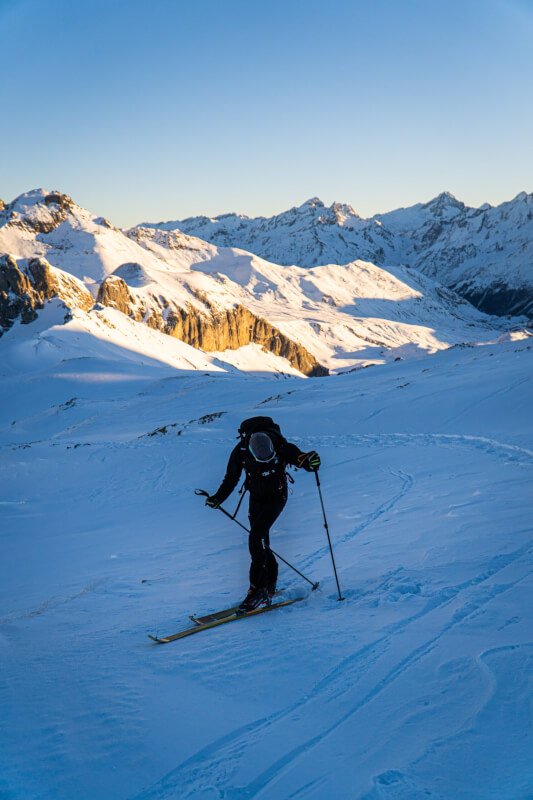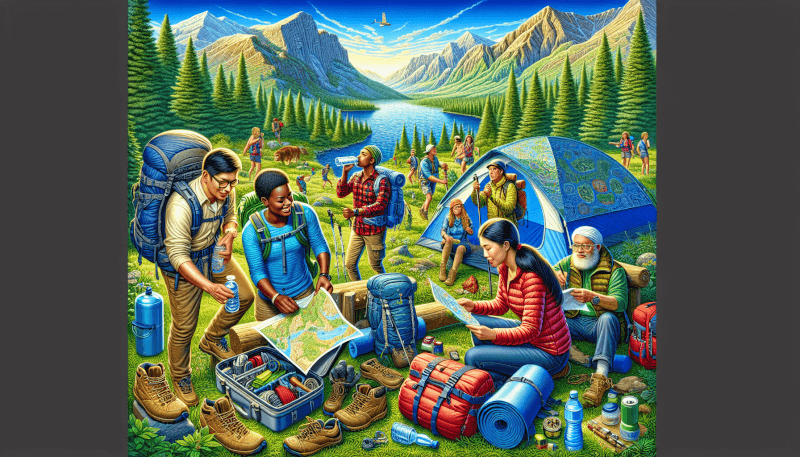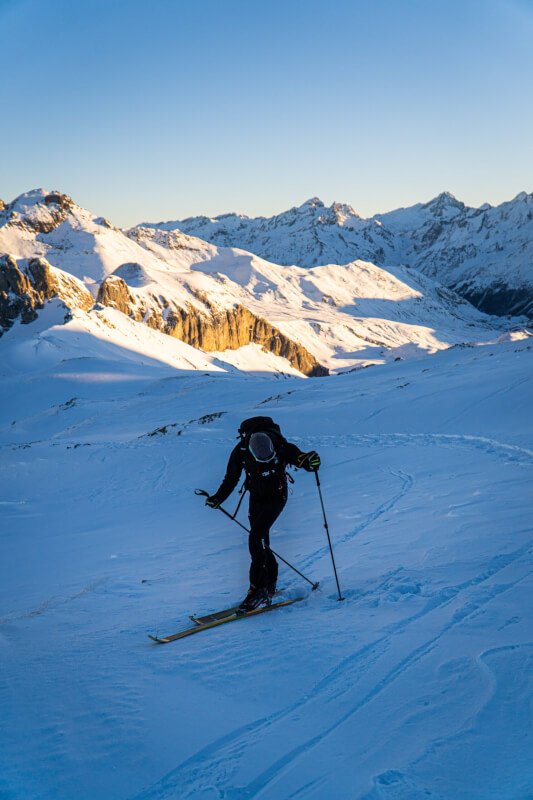Are you planning a camping trip and looking forward to hitting the hiking trails? Hiking can be a fantastic way to connect with nature, challenge yourself, and discover breathtaking landscapes. However, it’s important to be prepared and equipped with some essential tips to ensure a safe and enjoyable hiking experience. From choosing the right footwear to packing the necessary supplies, this article will provide you with all the information you need to make your hiking adventure on your camping trip an unforgettable one. So, grab your backpack and get ready to explore the great outdoors!

Planning and Preparation
Research the Hiking Trails
Before embarking on your hiking adventure, it’s important to research the hiking trails available in the area you plan to visit. Look for trails that match your fitness level and experience. Take note of the distance, elevation gain, and any specific requirements or restrictions for each trail. This research will help you choose the perfect trail for your hiking abilities and ensure that you have an enjoyable and safe experience.
Check the Weather Forecast
Checking the weather forecast is crucial when planning a hiking trip. Be sure to check the forecast for both the starting point and the destination of your hike. Rain, thunderstorms, extreme heat, or cold temperatures can have a significant impact on your hiking experience and safety. It’s always better to reschedule your hike if the weather conditions are unfavorable or potentially dangerous.
Pack the Right Gear
Packing the right gear is essential to ensure a comfortable and safe hiking experience. Some essential items to bring include:
- Backpack: Choose a backpack that is comfortable and fits well, allowing you to carry all your essentials without straining your back.
- Hiking shoes or boots: Invest in a sturdy and comfortable pair of hiking shoes or boots that provide good traction and support for your feet.
- Clothing: Dress in layers to adjust to changing weather conditions. Pack a waterproof and windproof outer layer to protect you from the elements.
- Navigation tools: Carry a map and compass, or use a GPS device or smartphone navigation apps to help you navigate the trails.
- First aid kit: Be prepared for any minor injuries by packing a basic first aid kit with bandages, antiseptic, pain relievers, and any necessary medications.
- Water and snacks: Stay hydrated and energized by carrying enough water and nutritious snacks to sustain you throughout the hike.
- Other essentials: Don’t forget to pack a whistle and flashlight for emergencies, sunscreen and bug repellent to protect your skin, and a hat and gloves for added protection.
Plan Your Route
Planning your route is an important part of hiking preparation. Study the trail map, take note of any trail markers or intersections, and familiarize yourself with the landmarks along the way. This will ensure that you stay on the designated trail and avoid getting lost. Consider the distance, elevation gain, and estimated hiking time when planning your route, and make sure it aligns with your fitness level and timeframe.
Inform Someone About Your Hiking Plans
Before heading out on your hike, it’s crucial to inform someone about your hiking plans. Share details such as the trail you’ll be hiking, your estimated start and end times, and the expected duration of your hike. This information can be vital in case of an emergency or if you fail to return as planned. It’s always better to have someone aware of your plans and ready to assist if needed.
Safety Measures
Check Your Physical Fitness
Before embarking on a hiking trip, it’s important to assess your physical fitness level. Hiking can be physically demanding, especially if you’re tackling steep or long trails. If you haven’t been physically active, start with shorter and easier hikes to build up your stamina and strength. Regular exercise and cardiovascular activities can also help improve your overall fitness and prepare you for more challenging hikes.
Hike with a Buddy
One of the best safety measures you can take when hiking is to hike with a buddy. Hiking alone can be risky, especially in remote areas or unfamiliar trails. Having a hiking buddy ensures that you have someone to assist you in case of an emergency, provide additional motivation and support, and make the overall hiking experience more enjoyable. If you can’t find a hiking buddy, inform someone about your plans and expected return time.
Learn Basic First Aid
An essential skill for any hiker is basic first aid knowledge. Accidents can happen on the trails, and being prepared to provide immediate first aid can make a significant difference in the outcome. Take a first aid course to learn how to handle common hiking injuries, such as sprains, cuts, and insect bites. Always carry a basic first aid kit and ensure it is stocked with necessary supplies. Additionally, it’s wise to have a basic understanding of CPR and how to respond in emergency situations.
Stay Hydrated and Well-Nourished
Proper hydration and nutrition are essential for a safe and enjoyable hiking experience. Dehydration can lead to fatigue, dizziness, and even heatstroke, while inadequate nutrition can result in low energy levels. Carry enough water to stay hydrated throughout the hike, and drink regularly even if you don’t feel thirsty. Pack nutritious snacks that provide sustained energy, such as granola bars, trail mix, or dried fruit. Avoid relying solely on sugary or high-sodium snacks, as they can cause a crash in energy levels.
Watch Your Step and Stay on the Trail
While hiking, it’s important to watch your step and stay on the designated trail. Pay attention to your surroundings, especially when navigating uneven terrain or crossing streams. Keep an eye out for potential hazards like loose rocks, tree roots, or slippery surfaces. Straying off the trail can damage vegetation, disturb wildlife habitats, and puts you at risk of getting lost. Respect the trail and leave it as you found it to preserve its natural beauty for future hikers.
Navigation Skills
Carry a Map and Compass
Carrying a map and compass is essential for navigation purposes. Even if you rely on GPS or smartphone navigation apps, it’s crucial to have a backup plan in case of battery failure or signal loss. Familiarize yourself with the map and learn how to read its symbols, contour lines, and trail markings. Practice using a compass to orient yourself and determine your direction. These navigation tools will help you stay on track and navigate the trails more confidently.
Use GPS or Smartphone Navigation Apps
GPS devices and smartphone navigation apps can be valuable tools for hikers. They provide real-time information about your location, elevation, and distance traveled, making it easier to follow your planned route. However, it’s essential to remember that technology can sometimes fail or be unreliable in remote areas. Always carry a backup navigation tool, such as a map and compass, and be prepared to navigate without relying solely on electronic devices.
Learn How to Read Trail Markers
Trail markers are signs or symbols along the trail that help hikers stay on course. Take the time to learn how to read and interpret trail markers specific to the area you’re hiking in. These markers may be color-coded, contain arrows or symbols, or have specific shapes. Understanding trail markers will prevent you from getting lost and ensure that you’re following the correct path.
Pay Attention to Landmarks
Landmarks are distinct features on the trail that can serve as reference points for navigation. These may include prominent rock formations, streams, or unique trees. Take note of these landmarks before and during your hike, as they can help you gauge your progress and location. They will also be useful if you need to retrace your steps or provide identifiable information when seeking assistance.
Proper Clothing and Footwear
Dress in Layers
Dressing in layers is essential for hiking, as it allows you to adjust your clothing to changing weather conditions and your activity levels. Start with a moisture-wicking base layer that will draw sweat away from your skin and keep you dry. Layer on insulating garments like lightweight fleece or down jackets to retain heat in colder weather. Finally, top it off with a waterproof and windproof outer layer to protect you from rain and strong winds.
Wear Moisture-Wicking Clothing
Wearing moisture-wicking clothing is crucial to keep you comfortable and dry during your hike. Moisture-wicking fabrics, such as polyester or merino wool, help transport sweat away from your skin, allowing it to evaporate more quickly. This helps regulate your body temperature and prevents you from feeling clammy or chilled. Avoid wearing cotton, as it retains moisture and can leave you feeling damp and cold.
Choose Sturdy and Comfortable Footwear
Selecting sturdy and comfortable footwear is essential for a successful hiking trip. Invest in a pair of hiking shoes or boots that provide good ankle support, cushioning, and traction. Make sure they fit well and allow for toe movement without being too loose. Break them in before your hike to avoid blisters or discomfort on the trail. Consider the terrain and weather conditions when choosing footwear. Opt for waterproof options if you anticipate encountering wet or muddy trails.
Protect Your Head, Hands, and Feet
Protecting your head, hands, and feet is crucial during a hike, as these body parts are most susceptible to heat loss, sunburn, or injuries. Wear a hat or a cap to shield your head from the sun and keep it warm in colder temperatures. Gloves or mittens will provide warmth and protect your hands from cold or rough surfaces. Don’t forget to wear appropriate socks that wick away moisture and provide cushioning for your feet. Additionally, consider wearing gaiters to protect your lower legs and ankles from rocks, debris, or wetness.

Packing Essentials
Carry Enough Water
Staying properly hydrated is essential for a safe and enjoyable hiking experience. Dehydration can lead to fatigue, dizziness, and even heatstroke. Carry enough water to last you for the duration of your hike, and drink regularly, even if you don’t feel thirsty. As a general guideline, aim for at least half a liter of water per hour of hiking. Consider using a hydration bladder or water bottles that are easy to access and refill during your hike.
Pack Nutritious Snacks
Hiking can be physically demanding, and proper nutrition is crucial to sustain your energy levels. Pack a variety of nutritious snacks that are lightweight, non-perishable, and easy to eat on the go. Some examples include trail mix, energy bars, dried fruit, jerky, or sandwiches. Aim for snacks that provide a balance of carbohydrates, protein, and healthy fats to keep you fueled throughout your hike. Don’t forget to pack extra snacks in case of delays or emergencies.
Bring a First Aid Kit
Carrying a well-stocked first aid kit is essential for any hiking trip. It should include basic supplies to treat common hiking injuries, such as adhesive bandages, gauze pads, antiseptic wipes, blister treatments, pain relievers, and any necessary medications. Additionally, consider adding items like a small pair of scissors, tweezers, and a whistle for further emergencies. Familiarize yourself with the contents of your first aid kit and know how to use them effectively.
Carry a Whistle and Flashlight
A whistle and a flashlight are two essential items for any hiker’s pack. A whistle can be used to signal for help in case of an emergency or if you’re lost. It is a loud and easily recognizable sound that can carry further than your voice. A flashlight is crucial if you find yourself hiking after dark or if your hike takes longer than expected. Choose a small and lightweight flashlight that provides sufficient brightness and has spare batteries.
Don’t Forget Sunscreen and Bug Repellent
Protecting your skin from the sun’s harmful rays and pesky insects is important during a hike. Apply a broad-spectrum sunscreen with a high SPF before setting out on your hike, and reapply as needed throughout the day. Keep in mind that even on cloudy days, UV rays can still penetrate through the clouds and cause sunburn. Additionally, apply bug repellent to exposed skin to ward off mosquitoes, ticks, and other biting insects. Look for products with active ingredients such as DEET, picaridin, or oil of lemon eucalyptus for maximum effectiveness.
Leave No Trace Principles
Dispose of Waste Properly
When hiking, it’s essential to follow the principles of Leave No Trace. This means disposing of waste properly and respecting the environment. Pack out all your trash, including food wrappers, tissues, and other waste. Avoid leaving any trace of your presence by not littering or burying waste, as it can harm wildlife and pollute water sources. If you need to use the bathroom, follow the principles of Leave No Trace by digging a small hole away from water sources, trails, and campsites.
Respect Wildlife and Their Habitat
Wildlife encounters can be exciting during a hike, but it’s important to observe wildlife from a safe distance and respect their habitat. Do not approach or feed wildlife, as it can disrupt their natural behaviors and put both you and the animals at risk. Keep a safe distance, use binoculars or a camera with zoom instead. Remember that wildlife is best appreciated from afar to maintain their well-being and the integrity of their environment.
Avoid Taking Souvenirs
While it may be tempting to take home a souvenir from your hiking trip, it’s crucial to avoid doing so. Removing rocks, plants, or other natural features can disrupt ecosystems and damage the fragile balance of nature. Remember that these natural treasures are meant to be enjoyed by all hikers, both present, and future. Take photos instead and leave only footprints behind, preserving the natural beauty for others to enjoy.
Minimize Noise and Respect Other Hikers
When hiking, be mindful of the noise you make and respect other hikers’ desire for a peaceful experience. Keep your voices low and avoid playing loud music or making unnecessary noise. If you’re hiking with a group, maintain a reasonable distance between each other to allow other hikers to pass. Yield the right of way to faster hikers and be courteous when taking breaks or using shared spaces. Respecting other hikers’ enjoyment of the trails ensures a positive and harmonious hiking experience for everyone.

Hygiene and Sanitation
Practice Proper Hygiene
Maintaining proper hygiene during your hiking trip is essential to prevent illness and keep yourself comfortable. Wash your hands regularly, especially before eating or handling food. Use biodegradable soap and a small amount of water to clean yourself if necessary. Remember to dispose of soapy water away from water sources, following Leave No Trace principles. Additionally, use hand sanitizer if soap and water are not readily available.
Pack Biodegradable Soap and Toilet Paper
When hiking, it’s important to pack biodegradable soap and toilet paper to practice proper hygiene and sanitation. Biodegradable soap ensures that it won’t harm the environment and can break down naturally. Toilet paper should also be biodegradable and packed in a sealable bag to prevent littering or accidental damage to the environment. Always bury human waste in a small hole at least 200 feet away from water sources, trails, and campsites.
Follow Campground Rules and Regulations
If you’re camping at designated campgrounds during your hiking trip, be sure to follow the campground rules and regulations. These rules are in place to protect the environment and ensure a safe and enjoyable experience for all campers. Respect quiet hours, adhere to fire safety guidelines, and properly dispose of waste in designated containers. By following the rules, you contribute to the overall preservation and maintenance of the campground.
Use Approved Water Sources
It’s crucial to use approved water sources to prevent waterborne illnesses during your hiking trip. Always carry enough water with you, but if you need to refill, ensure that the water source is safe to drink from. Lakes, streams, and rivers may contain harmful bacteria, parasites, or chemicals, so it’s essential to use a water filter or purifier to treat the water. Boiling water for at least one minute is also an effective method to kill harmful microorganisms.
Weather Considerations
Plan for Extreme Weather Conditions
Weather conditions can change rapidly during a hike, so it’s vital to plan for extreme weather conditions. Check the weather forecast before your hike, but also be prepared for unexpected changes. Pack appropriate gear, such as a waterproof and windproof outer layer, extra layers for colder temperatures, and a hat and sunglasses for sun protection. Consider delaying or rescheduling your hike if severe weather conditions are forecasted.
Bring Rain Gear and Extra Layers
Rain can quickly dampen your hiking experience, so it’s crucial to bring rain gear and extra layers. Pack a lightweight and waterproof rain jacket and rain pants to keep you dry during an unexpected downpour. Additionally, bring a backpack cover or dry bags to protect your gear and belongings from getting wet. If you’re expecting colder temperatures, pack extra layers such as a fleece or down jacket to keep you warm in wet conditions.
Be Prepared for Temperature Changes
Temperature changes can occur throughout the day, especially in mountainous or high-altitude areas. Be prepared for temperature fluctuations by dressing in layers that can be easily added or removed as needed. Pay attention to weather conditions and adjust your clothing accordingly to prevent overheating or hypothermia. It’s better to be slightly overdressed than underdressed when it comes to temperature changes during your hike.
Seek Shelter in Emergency Situations
In the event of an emergency or severe weather conditions, it’s crucial to seek shelter immediately. Look for natural shelters like caves or overhangs, or find a sturdy building or structure if available. If no shelter is accessible, create an emergency shelter using materials from the environment, such as branches, leaves, and rocks. Being prepared to seek shelter can potentially save your life and protect you from the elements.

Hiking Etiquette
Yield to Other Hikers
Hiking etiquette involves yielding to other hikers on the trail. If you’re hiking uphill, yield to hikers coming downhill to avoid interrupting their momentum. Step aside when necessary to let faster hikers pass, and be respectful and considerate of all hikers, regardless of their speed or experience level. By practicing good hiking etiquette, you contribute to a positive and enjoyable hiking environment for everyone.
Avoid Disturbing Wildlife
Respecting wildlife and their habitat is an essential part of hiking etiquette. Avoid disturbing or approaching wildlife, as it can disrupt their natural behaviors and put both you and the animals at risk. Observe wildlife from a safe distance and use binoculars or a camera with zoom to get a closer look. Stay on designated trails and respect any wildlife protection guidelines or restrictions in the area.
Keep Noise Levels Down
Keeping noise levels down is important for maintaining a peaceful hiking environment and respecting other hikers. Remember that many hikers are seeking solitude and tranquility in nature. Speak softly or in low tones, turn off loud music or devices, and avoid making unnecessary noise or loud conversations. By minimizing noise, you contribute to a more enjoyable and serene hiking experience for both yourself and others.
Respect Private Property
Some hiking trails may pass through or near private property. It’s important to respect the boundaries and rights of private landowners. Stay on designated trails, avoid trespassing, and follow any posted signs or instructions. If the trail gets close to private property, be mindful of noise levels and avoid interfering with any activities taking place on the property. By respecting private property, you help maintain good relationships between hikers and landowners.
Emergency Preparedness
Know the Emergency Contact Numbers
Before heading out on your hike, it’s vital to know the emergency contact numbers specific to the area you’re hiking in. Research and jot down the local emergency services numbers, including the nearest ranger station or park office. Save these numbers in your phone and have a backup written copy in your backpack. In case of an emergency, knowing who to call can make a significant difference in receiving timely assistance.
Carry a Whistle and Signal Mirror
Carrying a whistle and signal mirror is an essential part of emergency preparedness. A whistle can be used to signal for help and is a loud and easily recognizable sound that can carry further than your voice. A signal mirror can reflect sunlight and catch the attention of search and rescue teams in emergency situations. These lightweight and compact items can greatly increase your chances of being located if you’re lost or require assistance.
Learn Basic Survival Skills
Having basic survival skills can be invaluable in emergency situations. Consider taking a wilderness survival course or familiarize yourself with essential skills such as building a shelter, starting a fire, finding and purifying water, and signaling for help. Learning these skills can provide you with the knowledge and confidence to handle unexpected situations and increase your chances of surviving until help arrives.
Create a Hiking Itinerary
Creating a hiking itinerary is a smart and responsible way to prepare for your hike. Before you start your trek, document your itinerary, including your planned route, start and end times, and any designated rest stops or campsites. Share this information with someone responsible, such as a family member or friend. In case of an emergency or if you fail to return as planned, this hiking itinerary will provide valuable information to locate you quickly and efficiently.
As you embark on your hiking adventure, remember that proper planning and preparation are key to a successful and safe experience. By researching trails, checking the weather forecast, packing the right gear, and informing someone about your plans, you set a solid foundation for a memorable hike. To ensure your safety, always assess your physical fitness, hike with a buddy, learn basic first aid, and stay hydrated and well-nourished. Enhance your navigation skills by carrying a map and compass, using GPS or smartphone navigation apps, and paying attention to trail markers and landmarks.
Proper clothing and footwear are essential for the comfort and safety of your hike. Dress in layers, wear moisture-wicking clothing, choose sturdy and comfortable footwear, and protect your head, hands, and feet from the elements. Packing essentials such as enough water, nutritious snacks, a first aid kit, a whistle and flashlight, and sunscreen and bug repellent ensure that you are adequately prepared for any situation. When hiking, remember to follow Leave No Trace principles, practice good hygiene and sanitation, and consider weather conditions.
Maintaining hiking etiquette, being prepared for emergencies, and respecting wildlife and private property are essential components of a responsible hiker. By adhering to these guidelines and having emergency contact numbers, carrying a whistle and signal mirror, learning basic survival skills, and creating a hiking itinerary, you are taking the necessary steps to ensure your safety and the safety of those around you. Enjoy your hiking adventure and embrace the beauty of nature while keeping these essential tips in mind. Happy hiking!



